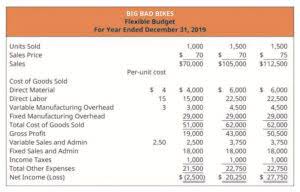Content

Using revenue projections to double-check expenses in financial forecasting is important because it helps to ensure that the business is financially viable and sustainable. By estimating the revenue a business is likely to generate, it becomes easier to determine how much money can be allocated towards expenses such as salaries, rent, and marketing. This helps to avoid overspending and running out of cash, which can be detrimental to the business. A time series analysis looks at historical data and how various variables have interacted with one another in the past.
- If you are presenting a financial forecast to investors or lenders, you’ll want to forecast all financial statements.
- Defining your financial forecast’s purpose is essential to determining which metrics and factors to consider when doing it.
- The sales force composite method uses the collective opinion of a company’s sales force to predict future sales.
- The applications vary slightly from program to program, but all ask for some personal background information.
- You might look at how companies similar to yours have planned their own growth.
You will be able to figure out the aim of your forecast after answering these questions. And that will help you choose the suitable method and develop accurate predictions. So they’re easier to understand, we have divided them into bottom-up and top-down approaches. Most often, companies that have been in business for a while use this forecasting type. The accuracy of the quantitative kind depends on the quality and availability of past data. Businesses that project future cash flow can know when they will have extra money to invest.
For more finance tips
Workday Adaptive Planning’s ability to support detailed bottom-up and top-down forecasts makes it a particularly attractive option for businesses of virtually any size. It allows you to create compelling forecasts based on targets from executive guidance or ground-level operational plans. And it doesn’t have to be a tedious task to analyze your financial data, thankfully there’s plenty of forecasting software tools available for this purpose.

We’re firm believers in the Golden Rule, which is why editorial opinions are ours alone and have not been previously reviewed, approved, or endorsed by included advertisers. Editorial content from The Ascent is separate from The Motley Fool editorial content and is created by a different analyst team. Adjust cash according to the expenses you plan to pay with cash, accounts payable for expenses paid on credit, and accounts receivable for credit sales. Long-term forecasts can address a time frame that looks many years beyond where your budgets end.
Draft a pro forma income statement
The former coalition pensions minister Steve Webb has pointed out that the increase next year will take half a million pensioners over the income tax threshold – giving the Treasury a windfall. Outsourced Chief Investment Officer service to institutional investors. He has previously served as Chief Investment Officer at Moola and FutureAdvisor, both are consumer investment startups that were subsequently acquired by S&P 500 firms.
The financial forecasting process includes the analysis of past business performance, current business trends, and other relevant factors. PlanGuru is a dedicated financial forecasting software — supporting 20 separate forecasting methods that can cover projections of up to 10 years. The program also allows you to incorporate non-financial data into financial forecast for startups your forecasts and has scenario analysis features to help you interpret the ramifications of potentially impactful events. Depending on your goals, these statements will cover different time spans. If you’re creating a financial forecast for your planning purposes, you should create pro forma statements covering six months to one year in the future.
Delphi method
By predicting this, you can make informed decisions about growing your business, like future financial planning, buying new equipment, and hiring additional staff. The most straightforward method of forecasting depreciation is the Straight-Line Method. For small business accounting, depreciation is used to allocate the cost of a purchased asset over its useful https://www.bookstime.com/articles/invoice-financing lifetime. By looking at how quickly you’ll get paid back for your investment, it forces you to answer the question if you’re comfortable with the time period. Revise your strategic plan by removing some goals and action items until you develop a plan you can live with. Forecasts help managers, analysts, and investors make informed decisions about the future.
Looking at historical data, create a realistic growth forecast for each account. Lenders and investors often ask for financial forecasts to see your strategic plan for the company. If you have a solid knowledge of finance and financial modelling, preparing your own financial forecasts often is the best solution. Yet, if your knowledge is limited or simply good enough, we strongly recommend not to do it yourself.
The budget you create can use information from your financial forecast, but it’s separate from the forecast itself. With straight line forecasting, a business gathers rough growth estimates — typically pulled from past figures — and applies them to coming months, quarters, or years. It’s generally employed when a company assumes it will see steady growth over a given period. A bottom-up financial forecast could start with a business taking a look at its sales volume — or the total number of units of its product it moved in a given period — from the previous year.
The income statement template is set up to automatically add up your total revenue (line 13), total costs (not including taxes, line 23), and net income (line 26). Complete the forecast of your income statement for the next three to five years. A good practice is to keep a list of the assumptions for each financial forecasting scenario so that you can have context around applicable changes in some of the numbers. This is a living, breathing document; don’t be afraid to adjust the assumptions and make changes to your forecasts as necessary. Additionally, the company may be able to secure funding from investors at a higher valuation than anticipated, allowing for further growth and expansion. In this financial forecast scenario, the company would also be able to manage their expenses effectively, keeping costs low and maximizing profits.






